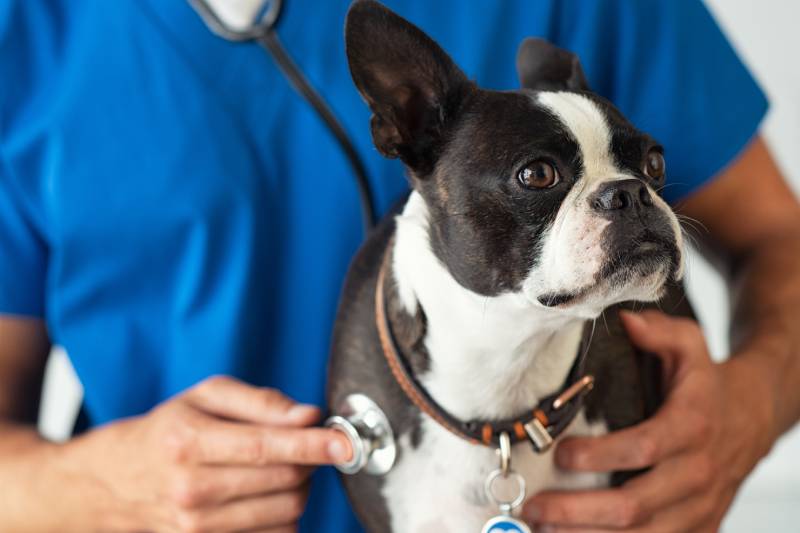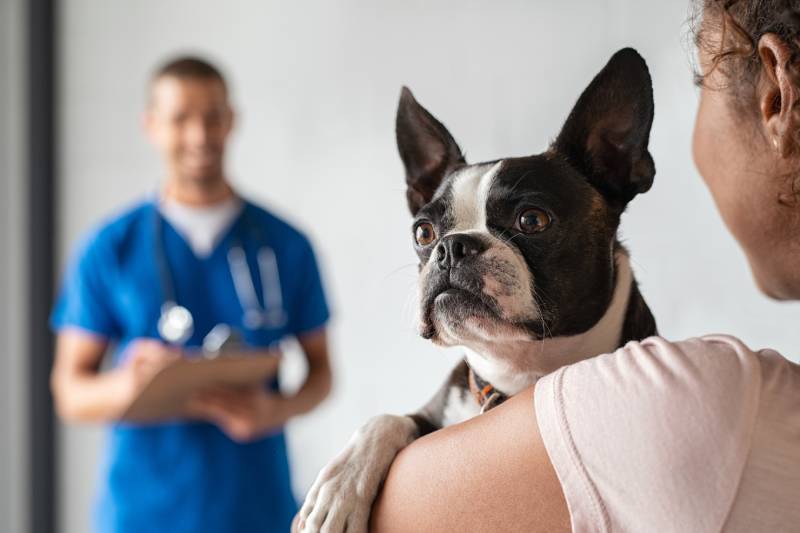- June 27, 2023
Boston Terrier Pregnancy: A Week-by-Week Guide & Vet Approved Advice



The information is current and up-to-date in accordance with the latest veterinarian research.
If you’re a Boston Terrier owner and your pooch is expecting, congratulations! Pregnancy is a journey full of physical and emotional changes, but it’s an exciting time that ultimately results in new life. Here is a week-by-week guide to Boston Terrier pregnancy to ensure a healthy pregnancy and safe delivery.

About Dog Gestation
The average gestation period, or the length of pregnancy, is 63 days, but delivery can happen between days 56 and 68 of the pregnancy.
What to Know About Boston Terriers and Pregnancy/Delivery
Boston Terriers are generally a healthy breed, but there are some risks associated with pregnancy and whelping. Boston Terriers have been known to have litters of fewer than four puppies, and due to their size, they may also be more likely to experience dystocia (difficulty giving birth). You’ll want to be extra vigilant of your bitch’s health during her pregnancy and delivery in order to ensure the safety of both mother and pups. If you notice any problems, it’s important that you contact your vet right away.
Week-by-Week Boston Terrier Pregnancy Guide
Preparation – Before Pregnancy

Prior to mating your Boston Terrier, you should visit your vet to have a health check and make sure she is up to date with the recommended vaccinations and parasite control. Her puppies will rely on the immunity she passes onto them, so you need to make sure she is able to pass on the best. This is also a good time to talk about what is involved in mating, pregnancy and whelping.
Week 1
Your Boston Terrier has just been mated, but you may not notice any changes yet. The fertilized eggs begin to divide, and by the end of the week, the embryos will form and start to travel down the uterus. Your dog may experience some hormonal changes such as increased appetite, restlessness, and nesting behavior.
Week 2
The embryos have implanted in the uterine lining, and the fetuses start to develop. Your Boston Terrier may not show any physical changes yet, but you need to avoid any medication unless it’s recommended by a veterinarian. Continue with her normal level of exercise.
Week 3
By week 3, the fetuses are rapidly growing, and your dog may start to sleep more and show signs of lethargy. You must provide her with enough nutrients while avoiding any strenuous activity that causes strain to the mother and affects fetal development.
- Focus on a nutrient-rich diet that includes protein and calcium. A simple way to do this is to make up about a third of her diet with puppy food.
- Avoid any rough play or excessive exercise that could impact the growing fetus.
Week 4
By week 4, the fetuses are growing well, and you may notice your dog starting to carry extra weight. You should schedule a vet visit at this point to ensure the proper monitoring of your dog’s health and development of the fetuses.
- Continue providing a healthy diet with plenty of calcium and protein.
- Continue avoiding any strenuous activities that could affect the fetuses.
- Provide a safe and comfortable place for your dog to rest and sleep.
Weeks 5 & 6

At this point, the organs of the fetuses are almost fully developed, and you can book an ultrasound to confirm pregnancy. You should continue providing nutritious meals as well as exercise in moderation.
- Continue feeding your Boston Terrier nutrient-rich meals with plenty of calcium and protein
- Engage in regular moderate activity but avoid strenuous exercise
Week 7
2 weeks to go, and your Boston Terrier is getting close to her due date. You should not only be monitoring her health but also ensuring that she has a safe and comfortable place for the delivery. Start preparing for the arrival of the puppies by making sure you have enough blankets, puppy food, and other supplies on hand.
- Monitor health of mother dog closely
- Gather necessary items such as puppy food, bedding, and toys in preparation for puppies’ arrival
- Make sure you have spoken to your vet or veterinary nurse about what to do during and after whelping, such as stimulating the pups and making sure they are feeding
Week 8
At this point, your Boston Terrier’s abdomen will start to become swollen with milk due to hormonal changes. You may even be able to see some movement of puppies in the abdomen, but avoid the temptation to feel them as the pressure may cause discomfort for mom and distress to the pups.
- Provide extra bedding or blankets in preparation for whelping
- Keep an eye out for any signs such as panting, restlessness, or nesting behavior indicating readiness for delivery
- You should also keep an eye on her temperature, as it may drop slightly before the beginning of labor.
Week 9

This is the final week of pregnancy. Make sure all preparations are complete and you have a vet on call just in case anything goes wrong during delivery. Your Boston Terrier’s uterus will now be full with puppies ready to come into this world!
- Final checklist and make sure you have the vet’s number to hand in case of problems
- Monitor your dog’s temperature and keep an eye out for any signs of labor
- Provide your Boston Terrier plenty of water and nutritious meals to sustain her during delivery.

What Are The Signs of Whelping?
- 24-48 hours before delivery: Your Boston Terrier will start “nesting” to get ready for the birth. Digging in beds and blankets, making sure everything is just right.
- 0-12 hours before delivery: She will start panting, pacing and starting licking her abdomen or vulva.
- Go Time!: Lots of licking of the vulva, abdominal contractions and panting. You may see some light green or clear discharge from the vulva – this is quite normal, but if you see discharge that is very bloody or dark brown or black, it’s time to phone the vet.
- Once this stage has started, you should see your first pup within 2 hours.
- Once the first pup has been delivered, the next should follow within an hour, BUT if mom is tired, she may actually revert back to the pre-whelping stage for a rest. If she has been actively trying to deliver for more than 1 hour once whelping has started, call your vet.
- Pups will usually be delivered inside the placenta, which is a translucent gelatinous sac. The mother will usually break open the sac and start licking the pup to stimulate it, but sometimes she will need help. You can break the sac open by making a tear in an area away from the pup, but be careful as it will still be attached to the umbilical cord. Mom will normally chew through this, but monitor her closely as some overzealous dogs have been known to chew and pull too hard and cause damage.
- You can use some thread to tie off the umbilical cord; tie the thread tightly around the cord approximately 1cm from the pup. You can then cut the cord, leaving 1cm on the other side of the thread.
- If mom isn’t cleaning the pups well, wrap them in soft towels and rub them vigorously in a direction towards their head. This will stimulate them and help them cough and clear their airways.
- It might seem gross to us, but let mom eat the placentas. There are 2 reasons she will do this:
- in the wild, eating the placenta hides the scent from other predators
- it helps restore some of the nutrients lost during the birth

Signs of an Emergency During Delivery: What to Look Out for and When to Call Your Vet

Delivery complications can be dangerous for both your Boston Terrier and her pups. Knowing the signs of dystocia can help you quickly recognize when it’s time to call your veterinarian. These include heavy, excessive panting or breathing problems, difficulty delivering puppies, and excessive bleeding after delivery. If you notice any of these signs, contact your veterinarian at once.
Vets are often asked to perform elective cesarean surgeries on breeds that have a higher incidence of whelping problems, but a natural delivery is always the preferred and safest method. If a dog is unable to whelp naturally, it will likely have pups with similar problems, so future breeding should be avoided.
Here are some common labor and delivery complications and what your vet may do to treat them:
- Uterine inertia: This is a condition where the uterus fails to contract and deliver puppies. If this occurs, your veterinarian can administer oxytocin to help stimulate labor.
- Fetal distress: Fetal distress is when whelping is taking too long and causing the pups to experience physiological stress. Your vet may need to take measures such as performing a cesarean section in order to save the pups’ life.
- Retained placenta: Retained placentas occur when a portion of the afterbirth remains attached to the mother’s body. Treatment usually involves administering medication to help expel this tissue.
- Stuck puppy: If a puppy is stuck in the birth canal and cannot be delivered, your vet can attempt to manually remove it, but sometimes a cesarean will be needed.
- Prolonged labor: If your dog has been pushing for more than an hour without any progress, contact your veterinarian for advice. They may administer oxytocin to help move things forward or assess whether a cesarean is needed.
- Refusal to nurse: If the puppies are not nursing, they may require supplemental feeding. Your veterinarian can provide you with advice and guidance in this situation.
- C-section: If your vet determines that a cesarean section is necessary, they will be able to direct you on what to expect and how to care for the mother and puppies afterward. Hopefully, the delivery will go smoothly, but if you have a pregnant Boston Terrier, you should be prepared for the possibility of a cesarean, which can cost around $2000-3000.
How to Care for Your Boston Terrier During All Stages of Pregnancy, and Beyond

Prenatal Care
Make sure your Boston Terrier receives all necessary vaccinations, check-ups, and other preventive care. You should also feed her high-quality puppy food to meet the increased nutritional needs of pregnancy and lactation.
Whelping Area
Ensure that the whelping area is comfortable and safe for both mother and puppies. This area should be warm but not too hot. Make sure there are no drafts and plenty of bedding available for warmth. It should have walls high enough to keep pups in, but low enough for mom to get out to take a break.
Postnatal Care
After delivery, you should continue to monitor your Boston Terrier for signs of distress or discomfort such as panting, restlessness, or anorexia. If any issues arise after birth, contact your vet immediately.
Puppy Socialization
Once the puppies have had their first vaccination, begin introducing them to different people and animals. This helps the puppies become well-socialized and more confident in their environment. Exposing them to different noises will also help them become well-adjusted and confident.
Weaning
When the puppies are around 6 weeks old, it is time to start weaning. You can help this process along by providing solid food alongside nursing from mom from 4-5 weeks.
Ultimately, caring for your Boston Terrier during her pregnancy and delivery is of utmost importance. Once delivered, continue to keep an eye on both mother and pups to ensure they remain healthy and happy throughout their development. Good luck!

FAQs About Boston Terrier Pregnancy and Delivery
Q: What should I do if my Boston Terrier is overdue?

A: If your pup has gone more than 68 days since being bred and you don’t see any signs of labor, contact your veterinarian for a check-up. Your vet may need to induce labor to ensure the health and safety of your dog and puppies.
Q: Are there any risks associated with Boston Terrier pregnancy?
A: Yes, small breed dogs like Boston Terriers may be at higher risk of dystocia. It’s important to monitor your dog’s health throughout the pregnancy to reduce the chances of complications. Speak with your veterinarian about any concerns you have.
Q: What should I do during labor?

A: Stay calm and prepared. Have clean towels and blankets ready, as well as any other materials your veterinarian suggests. Contact your vet if you have any questions or concerns about the delivery process. Make sure to provide a stress-free, comfortable environment for your dog during labor.
Q: How can I care for my Boston Terrier after delivery?
A: After the puppies are born, monitor your dog’s health and provide plenty of rest. Keep a close eye on her temperature and watch for signs of infection. Provide food and water to ensure she stays properly hydrated and fed. Talk to your veterinarian about any other post-delivery care instructions.
Q: How much should I feed my pregnant Boston Terrier?
A: During pregnancy, your Boston Terrier will need more calories and nutrients than usual. Talk to your veterinarian about your dog’s food and feeding schedule. They may recommend increasing her daily intake by 25–30% throughout the day. This will help ensure she stays properly nourished and able to maintain steady weight gain.

Conclusion
Your Boston Terrier’s pregnancy journey is quite unique. A Boston Terrier pregnancy is approximately 9 weeks long, but those few weeks will likely be full of changes and surprises. Consult with a veterinarian throughout the pregnancy, and always ensure that you provide the best care for your Boston Terrier. By following these guidelines, you’ll be in the best position to ensure the health and safety of your loyal and affectionate Boston Terrier.
Featured Image Credit: Siva Nattharom, Shutterstock
Tags
What do you think?
Related Articles

New Puppy Checklist: Gear You’ll Need for Your New Dog
Getting a new puppy is really exciting, but before you welcome them home, it’s important to prepare your space for them. Since puppies need a

How Big Do Mini Poodles Get? Vet Reviewed Average Weight & Growth Chart – Dogster
The information is current and up-to-date in accordance with the latest veterinarian research. Learn more » When you buy a Miniature Poodle, you might not

Can Police Dogs Smell Nicotine? Vet Verified Facts & Info – Dogster
The information is current and up-to-date in accordance with the latest veterinarian research. Learn more » While cigarette sales have been declining steadily for decades,

How Old Is 5 in Dog Years? Vet-Approved Guide to Each Size of Dog – Dogster
The information is current and up-to-date in accordance with the latest veterinarian research. Learn more » A common method for calculating a dog’s age is

